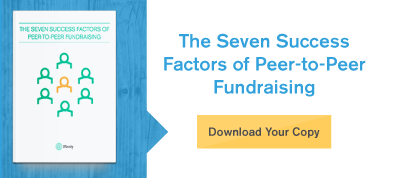Three Project Management Techniques To Fuel P2P Fundraising Success
At its core, peer-to-peer fundraising is a simple concept – you ask your supporters to enlist their networks on behalf of your cause. Easy enough, right? But in fact, peer-to-peer fundraising has plenty of nuances and complexities that often require the perspective and experience of an expert practitioner.Here at Plenty, we spend a lot of our time staying up-to-date on the latest peer-to-peer trends, technology, and thinking. However, we often find that before we can address issues surrounding the peer-to-peer model for our clients, we first have to focus on their project management tools and processes. The complexities of P2P we mentioned earlier require solid project management support in order for them to function correctly. It is important that these tactics are present not only at the leadership level, but throughout all parts of an organization. Therefore, a key part of the consultation we give organizations centers on project management techniques that ensure planning, communication, and accountability for peer-to-peer programs are optimal at every level of the organization. One of the first concerns around incorporating the proper project management techniques is the matter of resources. Due to staff and budget constraints, it’s not always realistic for every program and project to have a project management professional (PMP) at the helm. And dare I say, as a PMP myself - it’s sometimes not the best solution anyway.Luckily, whether you have a certified PMP on board or not, there are three project management techniques that you can use to accomplish your business goals. We have returned to these methods time and again to help the organizations we work with increase their efficiency, drive projects forward, and achieve growth. Although they’re not necessarily the most glamorous techniques, their beauty lies in the fact that they can be done relatively quickly and painlessly, and most importantly, they’ll dramatically improve the likelihood of a successful project.
One of the first concerns around incorporating the proper project management techniques is the matter of resources. Due to staff and budget constraints, it’s not always realistic for every program and project to have a project management professional (PMP) at the helm. And dare I say, as a PMP myself - it’s sometimes not the best solution anyway.Luckily, whether you have a certified PMP on board or not, there are three project management techniques that you can use to accomplish your business goals. We have returned to these methods time and again to help the organizations we work with increase their efficiency, drive projects forward, and achieve growth. Although they’re not necessarily the most glamorous techniques, their beauty lies in the fact that they can be done relatively quickly and painlessly, and most importantly, they’ll dramatically improve the likelihood of a successful project.
1. Create Your Charter
The great philosopher Yogi Berra once said, “If you don’t know where you’re going, you’ll end up someplace else.” Which is why, if you only do one thing before you start a project, do this: write your charter. In project management language, your charter is a simple, one sheet document that lays out your project’s requirements, resources, and budget.First, identify your requirements by asking yourself what you’re trying to accomplish, in what time frame, and what success will look like. Remember, the more objective and numbers-based your goals and metrics are, the easier it’ll be to know if you’ve been successful.Next, list your resources: who is the project lead, the person responsible for driving the project forward and ensuring it reaches completion? Who is the project sponsor, the person that the lead is accountable to and can go to when there are obstacles they cannot eliminate on their own? Who’s the project team, the resources the lead can utilize to accomplish the project? Identifying these key players and their roles up front will help you manage responsibilities and bandwidth early on in the project. The last thing in the charter is the budget. How much personal time and money does the lead have to accomplish the project?Once you’ve made your charter, the project lead and sponsor should discuss the charter, and sign it once they’ve come to an agreement. This simple step will ensure an efficient use of time and money by setting expectations and providing a reference for any future discussions meant to clarify the goal of the project.
2. Use A RACI Chart
One secret weapon used by project managers is the RACI chart. The RACI chart, also known as a responsibility assignment matrix, is invaluable for setting up your team for clear communication and accountability.RACI is an acronym for responsible, accountable, consulted, and informed. Quite simply:
-
The responsible individual needs to do and coordinate the work
-
The accountable individual needs to ensure the work is done to specification
-
The consulted individual gets to express their opinion
-
The informed individual gets to be told about progress and decisions
During the first project meeting, when the sponsor is present, use the requirements from the charter as headings in the matrix. Then, lead a discussion about who plays what role for each of the requirements. The key here is to discuss the roles as a group and make sure that everyone is comfortable with and understands their part in the project. This goes a long way in clarifying roles and establishing accountability - two big reasons projects do not meet their goals.
Then, lead a discussion about who plays what role for each of the requirements. The key here is to discuss the roles as a group and make sure that everyone is comfortable with and understands their part in the project. This goes a long way in clarifying roles and establishing accountability - two big reasons projects do not meet their goals.
Once you have the charter and RACI chart finished, take the last step and create a project plan. (Gasp!) Don’t worry - I don’t mean a hellacious 450-line project plan with dependencies and sub-tasks that your devoted sponsor expects you to update on a weekly basis. Instead, this should be an agreement among the project team on what they are doing this week, this month, and next month.If you’re an overachiever, then by all means do a 25-line project plan that details the start and end date, complete and incomplete tasks, the responsible individuals for each task, a place for notes etc. But if that level of detail overwhelms you, just stick with identifying tasks for this week, this month, and next month. That alone is a good start to gaining some project momentum.I have had great experiences with talented project managers who understand that project management techniques are a way to solve business problems - but I realize this is not true for everyone. If your team has a high success rate with projects, awesome! Keep doing what you’re doing. If you’re not having as much success as you want, I recommend trying all three of the techniques mentioned. You can start slow, pick one to begin with and move down the list, or you can adopt all three at the same time. Either way, you’ll quickly see the value in using these techniques and increase your success rate.
For more information on how to grow your P2P fundraising program in 2015 download our free Seven Success Factors e-book, which highlights the seven components critical to achieving fundraising success.
Share this
You May Also Like
These Related Stories
Three P2P Fundraising Problems To Solve In 2015

The #1 Reason Fundraising Programs Fail



No Comments Yet
Let us know what you think